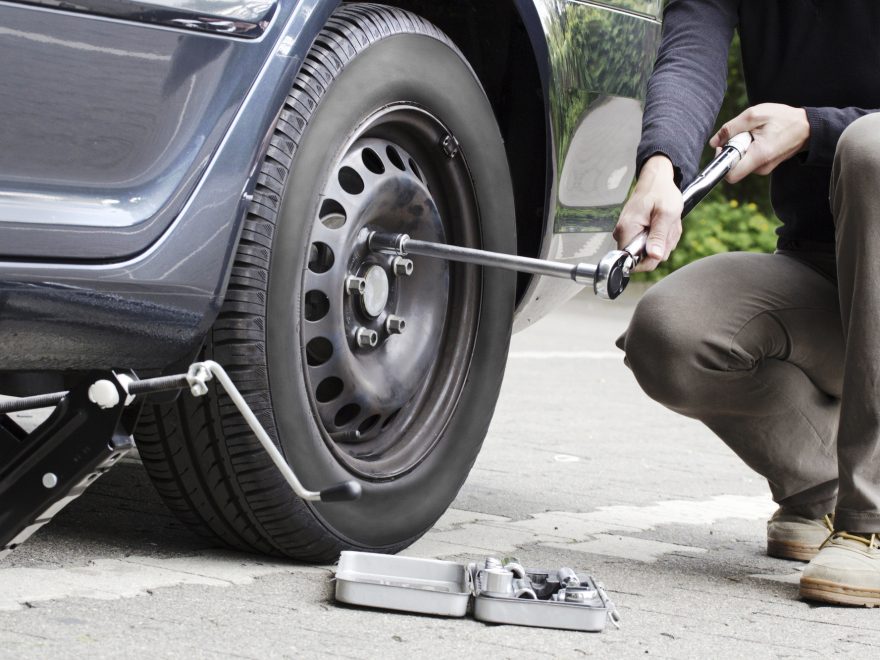Everyone should know how to change a tire, but in reality, most drivers still don’t know this valuable skill. This is true for Audi drivers; when you own such a nice car, you don’t want to take any risks in case you damage the car.
However, Audi cars don’t need anything fancy when changing tires.
Here are the materials you’ll need. Carry these with you, in case you ever get stuck with a leaky tire.
- Wrench
- Replacement or Spare Tire
- Locking Wheel Bolt Adapter
- Cap Removal Tool
- Jack
So next time you find yourself with a flat, just follow these steps to change your Audi tire.
Find Your Online Car Repair Manual Today! ->>
Before You Read…
Keep in mind, Audi doesn’t house ‘spare tires’ or a ‘doughnut tire.’ When you purchase an Audi tire, always purchase a second replacement tire. This way, you can avoid being towed to an Audi mechanic.
Depending on the model you purchased, Audi includes an inflator and sealant kit for this reason.
If your tire has a puncture or rupture, replace the tire but seal it and use it as a spare. Some models also come with a collapsible tire that you inflate before placing on the car.
How to Change an Audi Tire
Prepare the Bolts
Go to the cargo area. Grab your spare tire. Set your spare somewhere easily accessible, and grab your jack. Gather the rest of your materials and have them within easy reach.
Take your cap removal tool (it looks like a hook) and pull off the bolt covers.
Unlock the wheel bolt by using the wrench and locking wheel bolt adapter. Loosen the bolts, don’t remove them. If the bolts aren’t coming loose, turn the wrench in a counterclockwise direction.
During this step, you should start to inflate the collapsible tire. If you’re using a replacement tire, then skip this step.
Jack Up the Car
Slide your jack under the car. Align the jack with the jacking point that’s near the wheel.
Start to wind the handle. Wind until there’s two inches of space between the tire and the ground. At this point, completely remove the bolts. Set the bolts to the side, make sure you don’t lose them.
Pull Off the Wheel
Start to pull off the wheel. It will probably be heavy, so use both hands. If the wheel is too heavy, have someone help you. Call someone from the side of the road or you can call a local Audi mechanic.
Mount the Spare
Start to mount the spare or the replacement tire. Once the tire is fitted, attach the bolts. Screw them in place, but don’t tighten them. After your bolts are set, start to lower the jack. Lower the jack until the tire touches the ground.
Once the tire touches the ground, secure the bolts.
Your Tire is Now Replaced
Your tire should be fully secure. If necessary, follow the same steps for any other tires that need to be replaced.
If you’re experiencing issues, check your Audi repair manual.
Helpful Information
Tip 1
If you can, avoid changing your tire on the side of a busy road or at an intersection.
Sometimes, you don’t have a choice; if your tire gives in, you have to change it. But if you notice your tire is going flat, pull over to a side road and change your tire.
Never forget, always use your hazards if you’re pulled over. Use your parking brake to prevent your car from sliding off. If there are other passengers in your vehicle, make sure they’re out of the car while you’re changing your tire.
If passengers are in the way, they could risk getting injured. The extra weight in your car can make changing your tire more difficult.
Tip 2
Do not lie underneath your vehicle. You never know when your jack will slip, and the whole car will fall on you. Sit to the side of your car, right across from the tire.
Other Options
Audi has an incredible roadside program. If you call their roadside phone number, they will come to you and will change your tire. They will also state the nearest Audi mechanic who will help you replace your tire.
What Makes an Audi Tire So Different
Like any tire, the tires used on Audis can be punctured or ruptured. When this happens, change the tire. But don’t attempt to repair the tire. When your Audi tire is damaged, change the tire and drive to an Audi mechanic.
Audi creates their own performance tires. They do this for optimum speed and handling certain loads.
When an Audi tire is damaged, it no longer meets OEM standards. You’ll have to get a new tire.
To avoid getting a flat altogether, Audi recommends you replace your tire once the tread is 4/32-inch in depth. There is also a sensor that tells you when your tire is running low on air.
If your car does get a rupture or a puncture, you may not need to replace the tire.
Audi supplied run-flat tire, which resists the damage of a rupture or a puncture. It won’t resist the damage permanently, but you should be able to drive to an Audi mechanic with no issues.
Not All Tires are Created Equal
Audi tires are engineered for specific Audi models. Audi makes tires for each model to ensure you’ll achieve a quality ride. The tires and crafted to meet the specifications for each model.
Audi Technicians know your car best, so make sure you always get your tires from an Audi mechanic.
Never Fear When Your Audi Tire Goes Flat
Even premium cars get stuck with flat tires. Your slick ride can be a victim of low air pressure and a puncture in the tire. Audi understands this and is there for you when you need a replacement tire.
To avoid getting stuck, always pay attention to your low air pressure sensor. Keep a replacement tire on hand or an inflator to put air in that collapsible tire.
Visit our resources for more repair information and manuals on your Audi and other car makes.







